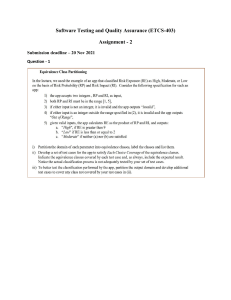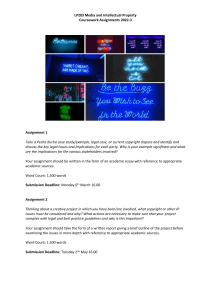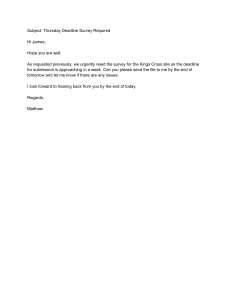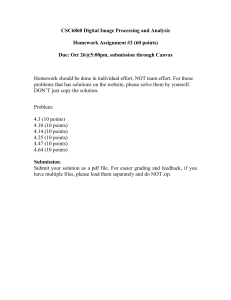LW3532 Technology and Cyber Law Assignment Brief 2021-22-approved
advertisement
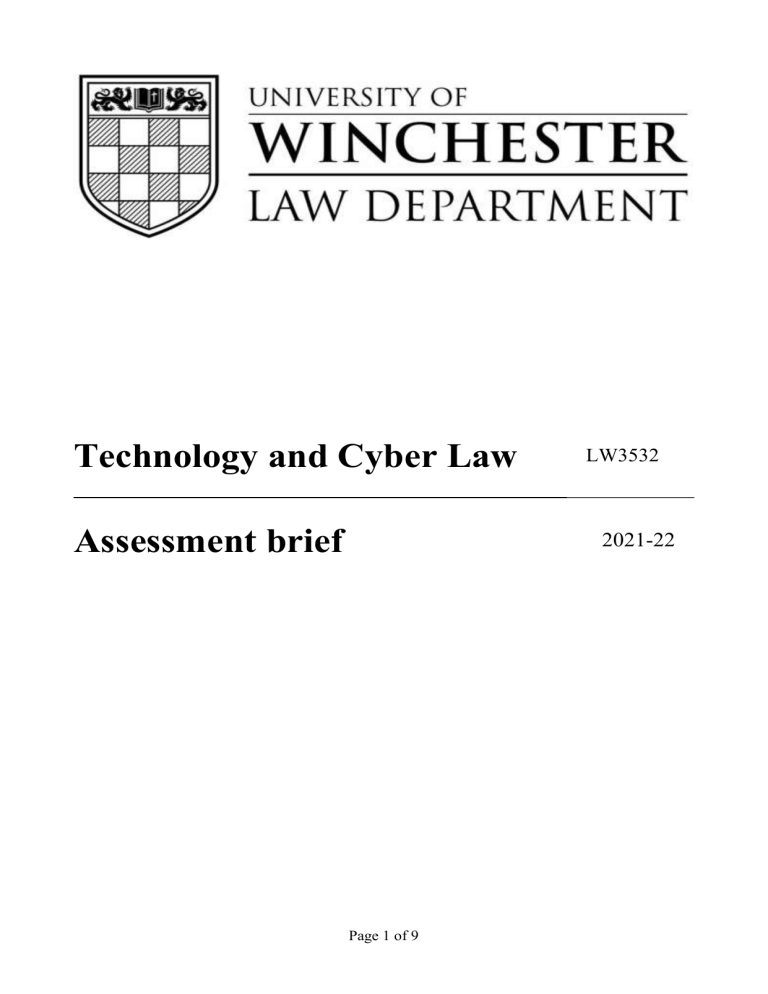
Technology and Cyber Law Assessment brief LW3532 2021-22 Page 1 of 9 Assessment Brief Module: 2021-22 Year LW3532 Module Tutor(s) Malcolm Dowden, Solicitor Contact E-mail Malcolm.dowden@Winchester.ac.uk Assessment Task Written assignment Assessment Weighting Submission Deadline Tuesday 17th May 2022 by 15:30 (UK Time) 100% 15 Working Days after Feedback Date submission deadline Assessment Formal Requirements The word count: The total word count for this assignment is: 3,500 What’s included in the word count? Included in the word count: Every word from the introduction to the conclusion, including headings and in-text quotations. Excluded from the word count: The title/assessment question. The bibliography. Footnotes (as per OSCOLA referencing). Significant amounts of text should not appear in the footnotes. Word count declarations: You must declare the word count for each assignment you submit. Students are advised to ensure that they make the most of the word count. This includes not being significantly under the word count, nor exceeding it. Part of the challenge of any given assessment is the need to adhere to the word count which has been set. Page 2 of 9 Tip: Take care when using the word count feature in Word! When you click on the number of words you’ve written, it will give you the option to ‘include footnotes and endnotes’ – for an accurate count, you will want to make sure that this is ‘unticked’! Identification Requirements: You must NOT put your name anywhere on work which you submit through Canvas. You must include your individual student ID number on every page. The University requests work to be formatted as follows: (a) Calibri font, size 11, black type (no colours); (b) 1.5 line spacing; (c) Page numbered throughout. Page 3 of 9 Assessment Task Written Assignment Please answer ONE of the following FOUR questions: “No single government or national regulatory authority can protect citizens from cybercrime and online harms because internet technologies do not recognise national or jurisdictional boundaries. International cooperation offers the only viable way to combat malicious use of the internet”. Critically analyse and evaluate this statement. OR “The Computer Misuse Act was created in 1990, when only 0.5% of the UK population had internet access. At the time, it was a landmark piece of legislation; 30 years later, it is in desperate need of reform as part of a general overhaul of the laws relating to cybercrime and online harms” (Lord Holmes of Richmond). Critically analyse and evaluate this statement. OR “UK legislation relating to personal data protection and investigatory powers strikes a fair and workable balance between privacy and surveillance and provides individual data subjects with meaningful legal protection”. Critically analyse and evaluate this statement. OR “Liability for harm caused by autonomous vehicles or by systems employing artificial intelligence is adequately dealt with by the law relating to product safety, contract and tort”. Critically analyse and evaluate this statement. Page 4 of 9 Assessment Learning Outcomes (a) Understand and critically evaluate the way that the law has responded to the use of computers, the Internet and other electronic technologies; (b) Apply the principles of intellectual property, contract and criminal law in the analysis of complex issues raised by the use of information technology and e-commerce; (c) Investigate, analyse and evaluate current legal issues arising from developments in information technology. Submission Instructions E-submission: Please submit an electronic copy of your work through Canvas. We cannot accept any submission sent to us via email under any circumstances. Instructions will be available on the module Canvas page. You must submit your assessment in a suitable format, e.g. Word. It is your responsibility to make sure that the assessment can be opened via Speedgrader. If it cannot be opened, you will be deemed to have not submitted. Once you have submitted, please check that your document has uploaded correctly. If you submit multiple times up until the deadline, your last submission prior to the deadline is the version which will be marked. If you submit a version after the deadline your work may be flagged as late by the system – it would be a good idea to make your module tutor aware of this. Where your assignment requires to submit more than one element (for example: a bundle and a skeleton) then, if one of those assessments is submitted late, then the entirety of your assessment will be deemed to be submitted late (thus affecting the overall grade you will receive). You MUST submit a bibliography. Please ensure your bibliography is at the end of the assessment (i.e. that it forms part of the same document). Page 5 of 9 Please note that by submitting your work you are agreeing that you have read the Academic Misconduct Policy and that you have understood the penalties regarding plagiarism and cheating, and that this piece of work complies with the requirements of those regulations. Late Submissions: In line with the University’s Assessment Regulations any work that is submitted up to 5 working days after the deadline (i.e. 1 week late) shall be accepted as a first attempt but the substantive mark shall be capped at the minimum pass mark, which is 40%. Submission of second attempts: As per Section B8 of the Assessment Regulations: “Second attempts submitted after the deadline, without extenuating circumstances, shall be deemed a fail and given a mark of 1% only, to indicate submission”. Therefore, the usual 5-working-day rule (for capped marks) does NOT apply to submissions of second attempts. Any late submissions of second attempts will result in a mark of 1%. Extenuating Circumstances: ‘Circumstances, normally exceptional and outside the control of the student, which prevent him/her from performing an assessment at the expected or required level.’ It is possible to apply for extension or deferral of an assessment if you are unable to submit on the due date. These are applied for through the Extenuating Circumstances procedure. Extenuating Circumstances are normally Circumstances relating to the health and/or personal life of a student which are of a sufficiently serious nature to result in them being unable to attend, complete or submit an assessment on time. These circumstances are also expected to be either: a) unforeseeable - in that the student could have no prior knowledge of the event concerned; and/or b) unavoidable - in that the student could have done nothing reasonably in their power to prevent or avoid such an event Page 6 of 9 Details of the Extenuating Circumstances policy, and the relevant application form, can be accessed here: https://www.winchester.ac.uk/about-us/leadership-and-governance/policies-andprocedures/?download=true&id=112 To apply, you must complete the application form and submit this with the relevant independent third-party evidence of your circumstances to the Law Administrator. For further guidance on what will be accepted as evidence, please refer to the Extenuating Circumstances Policy. Applications must be made before the assessment deadline. However, if the extenuating Circumstances takes place on date of assessment deadline, then applications may be made up to 5 days after this date. Please email Law.Admin@Winchester.ac.uk for more information about the ECs process. Page 7 of 9 Assessment Criteria The University-wide ‘Assessment Criteria’ can be found on the Module Canvas page, as well as the Law 21/22 Homepage. The table below explains to you how the University Assessment Criteria applies to this module. Technology and Cyber Law Learning Outcome Relevant Assessment Criteria Understand and critically evaluate the way that the law has responded to the use of computers, the Internet and other electronic technologies; Apply the principles of intellectual property, contract and criminal law in the analysis of complex issues raised by the use of information technology and e-commerce; Investigate, analyse and evaluate current legal issues arising from developments in information technology. • • Research and Enquiry Subject Knowledge and Understanding Applied and Practical Skills Applied and Practical Skills Academic Skills • • • • • Research and Enquiry Subject Knowledge and Understanding Applied and Practical Skills Values, Qualities and Attributes • • Categorical marking: The table below explains the potential range of grades which may be given to you for an assessment (also known as ‘categorical marking’). Please note that where an assessment has multiple components (i.e. questions/requirements) you will be given a categorical mark for each component, but your final grade for that assessment will not necessarily correspond to a categorical mark, as listed below. Assessment Criteria: A* 80-100% A 70-79 B 60-69 C 50-59 D 40-49 F 30-39 F 1-29 Law Department Categorical marking: 82 85 92 100 72 75 78 62 65 68 52 55 58 40 42 45 48 32 35 38 5 10 20 25 Pass Mark In order to complete this module, you need to achieve a mark of 40% overall. Page 8 of 9 Referencing & Bibliography You must ensure that you accurately cite and acknowledge any work taken from another source by including a footnote to the authority. You must use the OSCOLA referencing system for your footnotes and bibliography. Please refer to the Winchester Law guide to OSCOLA. This will be made available on Canvas. Failure to cite third party work included in your assignment may lead to issues of Academic Misconduct. The University’s Assessment Regulations is available on the University’s web pages at: https://www.winchester.ac.uk/about-us/leadership-and-governance/policies-andprocedures/?download=true&id=106 Page 9 of 9
